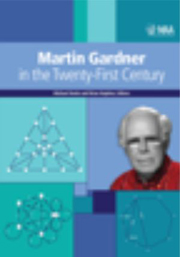Book contents
- Frontmatter
- Preface
- Contents
- I Geometry
- II Number Theory and Graph Theory
- III Flexagons and Catalan Numbers
- IV Making Things Fit
- V Further Puzzles and Games
- VI Cards and Probability
- 30 Modeling Mathematics with Playing Cards
- 31 The Probability an Amazing Card Trick Is Dull
- 32 The Monty Hall Problem, Reconsidered
- 33 The Secretary Problem from the Applicant's Point of View
- 34 Lake Wobegon Dice
- 35 Martin Gardner's Mistake
- VII Other Aspects of Martin Gardner
- Index
- About the Editors
33 - The Secretary Problem from the Applicant's Point of View
from VI - Cards and Probability
- Frontmatter
- Preface
- Contents
- I Geometry
- II Number Theory and Graph Theory
- III Flexagons and Catalan Numbers
- IV Making Things Fit
- V Further Puzzles and Games
- VI Cards and Probability
- 30 Modeling Mathematics with Playing Cards
- 31 The Probability an Amazing Card Trick Is Dull
- 32 The Monty Hall Problem, Reconsidered
- 33 The Secretary Problem from the Applicant's Point of View
- 34 Lake Wobegon Dice
- 35 Martin Gardner's Mistake
- VII Other Aspects of Martin Gardner
- Index
- About the Editors
Summary
Searching for a job is always stressful and, with unemployment rates at their highest levels in years, never more so than now. Applicants can and should use every advantage at their disposal to obtain a job which is rewarding, financially and otherwise. While this author believes a math major gives applicants many advantages as they search for their dream job, one often overlooked is the ability to strategize and schedule their interviews to maximize the chance of landing that job.
The secretary problem helps an employer find the optimal candidate for a job out of a large pool of applicants. The set up is as follows: only one person can be hired, and, for any pair of applicants, the employer has a strict preference for one of them that they can discern after seeing both. However, after each interview the employer must either accept or reject the candidate. If the candidate is the final person, the interviewer simply must accept them, as rejected candidates cannot be recalled. In the classical formulation of the problem, the goal is to select the best applicant overall.
What strategy can the employer use to maximize the probability of hiring the best overall applicant? It is clear that, other than the final candidate, you only hire an applicant if they are the best applicant you have seen to that point. Otherwise you are certainly not hiring the best person.
- Type
- Chapter
- Information
- Martin Gardner in the Twenty-First Century , pp. 243 - 248Publisher: Mathematical Association of AmericaPrint publication year: 2012

